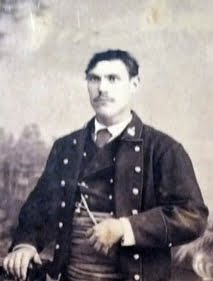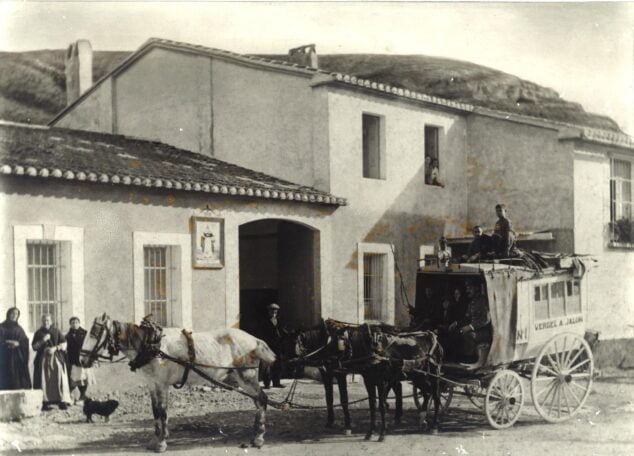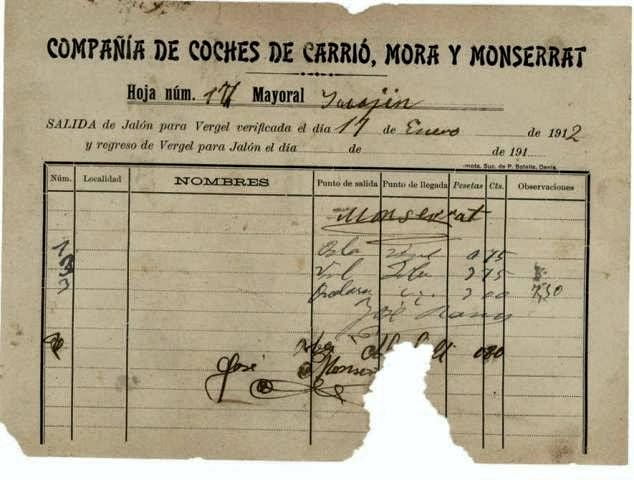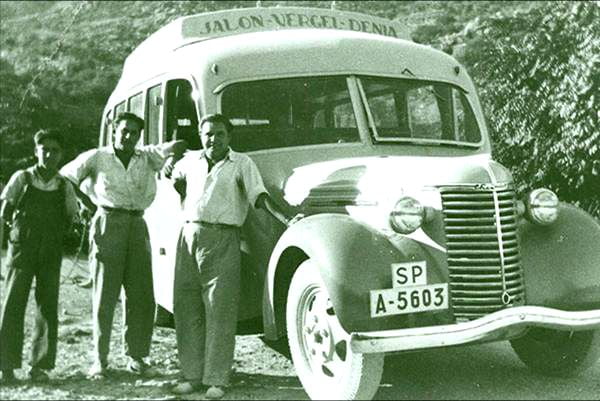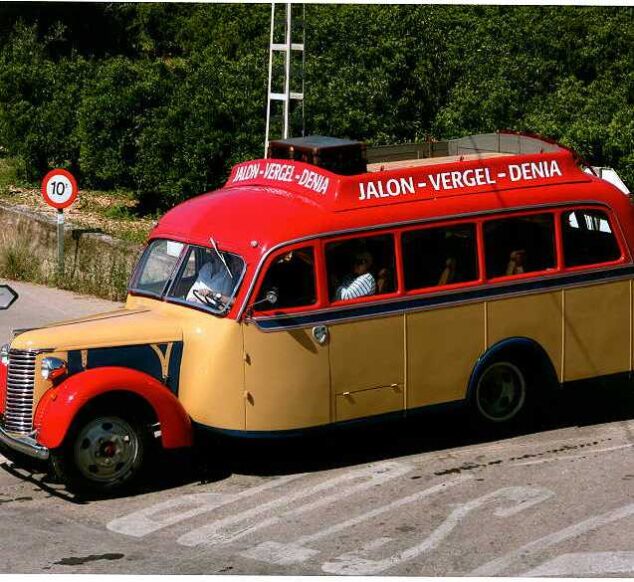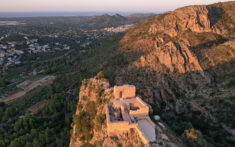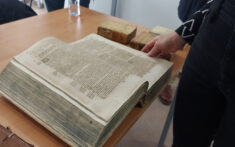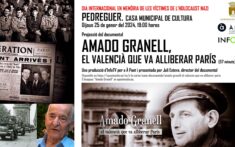Salvador Carrió Rovira “el Zurdo”, son of Salvador Carrió and María Rosa Rovira, was born in Sagra (Alicante), on August 1, 1853. From a humble family, from a very young age he practiced the trade of a farmer like most of his Sagrantine neighbors . Later, he will dedicate himself professionally to the peculiar trade of carriage transport known familiarly as "trajinante or muleteer". José Ignacio Uriol Salcedo published in the "Revista de Obras Públicas" in 1979 that the word "muleteer" comes from the expression "arre" of Arabic origin.
Salvador Carrió Rovira "El Zurdo". Patriarch and founder of the current company Autocares Carrió, died on January 17, 1922.
He married in the neighboring town of Tormos with Generosa Camps Ripoll, daughter of José Camps, a native of La Carroja (Vall de Gallinera), and Teresa Ripoll, a native of Tormos. As a result of this marriage, three children were born: Salvador Carrió Camps, married to María Ferrándiz Carrió and neighbors of Murla; María Teresa Carrió Camps, married to Carlos Llopis and neighbors of Parcent and María Rosa Carrió Camps, married to José Estela Oliver and neighbors of Sagra.
In his beginnings as a transport professional, Salvador Carrió Rovira was a carter and transported the stone and materials necessary for the construction of the bridge over the Jalón or Gorgos riverbed in a cart pulled by horses, located on the third-order road that a At the end of the 715th century and the beginning of the XNUMXth, it was being built between the towns of Pego to Benidorm, (current CV-XNUMX).
At the end of the works described, "El Zurdo" continued with his trade moving with the car along the roads of the Marina Alta, and where he passed people used to ask him to take them in his car, realizing that people also had the need to move from one place to another.
From these requests and requests the idea arose that, instead of carrying goods in his car, he could carry travelers. To do this, he transformed his car into a stagecoach or tartan pulled by 3 horses with a capacity for 7 or 8 passengers and began his journey as a passenger transporter heading to El Verger, a town where the railway station heading to Gandia and València was located. , until in 1911 this regular line would also be extended to Dénia.
In the Marina Alta, a region that has an extremely complex orography, the network of roads in its interior at the end of the XNUMXth century was non-existent or very bad with very poor roads. Historical writings refer that the towns of the interior were inhabited by a predominantly rural population of middle and lower middle social class with little or no mobility, who traveled little throughout their lives. Many hardly ever left the town where they were born. The few who did used to travel on foot, on horseback or by bicycle. If they had to travel, they did it in carts and / or tartanas pulled by horses.
Related to the modality of transport and displacement in the Marina Alta, several trajinantes or muleteers who were dedicated to the transport of merchandise and travelers driving a cart or diligence drawn by horses or other animals stood out since the years 1894/95.
In Benissa, several professional tartana drivers stood out, such as: Diegues el tartanero and the Pineda de Bellita. In Sagra, Murla, Parcent and Jalón, Salvador Carrió Rovira “El Zurdo” and in Pego Carlos Peretó Rovira –the lineage of the last name Peretó, arrived in Pego after 1731 from the neighboring town of Tormos–.
Although this way of traveling coped with the fact that the journeys became long and endless, it could take several days to travel the distance from one town to another, which made it inevitable that travelers and horsemen would need to rest and / or spend the night during the journey. This way of traveling caused sales, inns and inns to proliferate along the roads and highways between towns.
As a result of what was described, Salvador Carrió built four sales in our region of influence: Jalón, Parcent, Murla sales located in the port of Orba with the intersection of Murla and Sagra. This sale of Sagra would be managed by her daughter María Rosa Carrió Camps and her husband José Estela Oliver.
For several years the expeditions described were being carried out, but over the years, the great economic and social changes, together with the improvement of road infrastructures in the Marina Alta, promoted urban growth, creating at the same time greater mobility. of its inhabitants, and also, the result of the industrial revolution in which a machine with an explosion engine called an automobile arises, a machine that would cause great changes with the appearance of all kinds of vehicles, both for private and industrial use, etc.
But in the transport of travelers, it would lead to the mode of transport by carriage or diligence drawn by horses or other animals, as well as inns or sales, to gradually become practically in disuse and obsolete for this purpose.
In addition, road communications were improving, a good example of this, we can refer to what was published on May 31, 1900 in the Public Works section with No. 122 of the Official Gazette of the Province of Alicante. In this publication, the expropriation of land necessary for the construction of the third-order highway between the towns of Pego to Benidorm -current CV-715- is notified.
It should be noted that in the design and supervision of this highway, it was the responsibility of the Public Works engineer Juan Miró Moltó, –father of the writer Gabriel Miró Ferrer– who for this reason lived in Polop and when he came to our region for work reasons, he used to stay in the sales described above.
Later it would constitute the "Company of Cars of Carrió, Mora and Monserrat", and during several years they were carrying out the described expeditions to the town of El Verger, as described in a road map of January 17, 1912.
The norms that regulated this class of vehicles for the transport of passengers, were collected in the Municipal Ordinances and described in the Valencian Directory "Special guide of the provinces of Alicante, Castellón and Valencia of 1914".
The main towns to which our ancestors moved for administrative reasons or to carry out commercial transactions or for health reasons were Pego, Oliva, Gandía, Valencia, Dénia, Alcoy, Benissa and Alicante. With reference to our region, the described Valencian Directory also refers that from Pego there was a carriage service to the neighboring towns of Denia:
"Daily service at 8 in the morning for the price of 1 peseta per seat, to Oliva (daily, at 5 and 15 hours), to Parcent through Sagra, Orba and Murla (daily service)"
In addition, the "Carrió, Mora and Monserrat Car Company" carried out the service between Xaló, El Verger, Setla Miraflor and Mirarrosa (Els Poblets), later expanding to Denia with daily service at 9 in the morning and at 9 in the night for the price of one peseta, it also carried out the service between the towns of Sagra, Tormos, Orba, Murla, Parcent, Xaló, to the Benissa train station. This service connected the train stations of Benissa and El Verger and vice versa.
In 1924, the company began to be established as a passenger transport company, becoming part as founders of the Chamber of Mechanical Transport, today referred to as FENEBUS. And in the Contribution of motor vehicles of the year 1925, some rental cars appear for the first time for transport that took travelers to Dénia. It mentions the company El Zurdo, founded by Salvador Carrió Rovira who worked in Dénia, Setla and Mirarrosa, Benigembla, Parcent. In addition, it connected Pego with Sagra, Tormos, Orba, La Venta del Zurdo, Xaló, until it reached the Benissa train station.
In 1926, the government was forced to regulate the regular passenger transport, granting this company the operation of the regular passenger line between Xaló and El Verger, which was later extended to Denia. Although for reasons of survival of the company, Salvador Carrió Camps, son of the previous one and with the help of his brother-in-law José Estela Oliver formed the regular collective Carrió-Estela company. This company would be operating until 1949, and during these years practically all the regular lines that the company operates were created:
The 01-12-1926 Xaló - El Verger; on 20-07-1928 Beniarbeig - Dénia and in 1936 Castell de Castells - Dénia.
But in order to modernize the line that was carried out in stagecoaches and horse-drawn carriages and replace them with the new vehicles with internal combustion engines, both for private use and passenger transport, in 1929 Salvador Carrió Camps visited the International Exhibition of the Automobile of Barcelona and acquires a Chevrolet bus and a Fort model T passenger car.
These vehicles were manufactured in the United States of America. The Chevrolet bus had a 6 HP 20-cylinder gasoline engine and a 6-volt electrical installation. Its first technical inspection in Spain dates from February 1931.
On November 30, 1942, a new company would be consolidated as a result of the signing of the deed regulating rights between the two aforementioned partners Salvador Carrió Camps and José Estela Oliver, known as Autobuses “El Zurdo”. Later, when the company's fleet was updated, this bus was left in disuse, remaining high in traffic and stored in a garage.
During the Civil War, the bus was requisitioned by the Republican army. At the end of the contest he recovered and was bodied again in Carrocerías Miro de Alcoy, returning again to perform the service between Xaló-El Verger-Dénia. In the postwar period, due to the shortage of gasoline for the engines due to the oil blockade imposed on Spain by the sale of tungsten to the German state, the Spanish government promulgated an order limiting its consumption, so this bus was circulating for a certain time with a diesel-fueled engine until normalization.
In the 90s of the last century, it was again restored by Carrocerías Cervera de Albal (Valencia). It currently conserves the original engine and is owned by a collector of vintage cars from San Vicente del Raspeig. This Chevrolet bus is the one that appeared in the Canal Nou television series “La Alquería Blanca”.
The Fort car mod. T A-4356 also continues to circulate, and is currently owned by the company Alquiler Coches Rent a Car Giner de Benissa.
At present, the passenger transport company Autocares Carrió SL is run by the fourth generation, which began with Salvador Carrió Rovira "El Zurdo" from Sagrantino.

